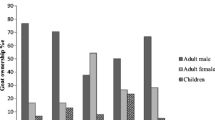Abstract
Smallholder Angora goat farming is widespread throughout Lesotho, resulting in the country being ranked second in global mohair production. The Lesotho landscape across which Angora goats are produced is divided into lowlands, foothills, mountains, and the Senqu river valley agro-ecological zones (AEZs). Husbandry practices, including those related to the control of gastrointestinal parasites (GIPs), are assumed to be influenced by the AEZ-determined farmers’ lifestyles. This study assessed how the AEZ of the Angora goat farming communities influences farmers’ demographic and socio-economic profiles, GIP knowledge, and goat management practices. Interviews were conducted with farmers from Maseru and Quthing districts selected from four areas that represent the AEZs. Our findings indicate that middle-aged males dominate goat farming in all AEZs. Also, most farmers only reached primary education, hence rely on experience for goat production. Familiarity with parasites differed among farmers from different AEZs although most viewed the GIP impact on goat health as high. Many farmers from all AEZs except the lowlands believed that diarrhoea, a common GIP symptom, is associated with their goat mortality. GIP control measures used include anthelmintics and traditional herbal medicines with differing frequency of administration. More than 80% of farmers reported offering supplemental feeds although other recommended goat management practices like shelter and sanitation were not commonly observed. All farmers reported reliance on communal grazing and many considered rangelands as sources of GIP infections. It is concluded that most husbandry practices are common across AEZs and that many of these are inadequate in controlling GIPs.



Similar content being viewed by others
References
Besier, R.B., Kahn, L.P., Sargison, N.D. and van Wyk, J.A., 2016. Diagnosis, treatment and management of Haemonchus contortus in small ruminants. In: Gasser, R.B., von Samson-Himmelstjerna, G., (Eds.), Haemonchus contortus and Haemonchosis – Past, Present and Future Trends, pp. 181–238.
Duguma, A.L. and Debsu, J.K., 2019. Determinants of livestock production development of smallholder farmers. Journal of Applied Science and Environmental Management, 23, 1535–1540.
García-Pérez, M.A. and Núñez-Antón, V., 2003. Cellwise residual analysis in two-way contingency tables. Educational and Psychological Measurement, 63, 825–839.
Hoste, H. and Torres-Acosta, F.J.F., 2011. Non chemical control of helminths in ruminants: adapting solutions for changing worms in a changing world. Veterinary Parasitology, 180, 144–154.
Hoste, H., Sotiraki, S., Landau, S.Y., Jackson, F. and Beveridge, I., 2010. Goat-nematode interactions: Think differently. Trends in Parasitology, 26, 376–381.
Houdijk, J.G.M., Kyriazakis, I., Kidane, A. & Athanasiadou, S., 2012. Manipulating small ruminant parasite epidemiology through the combination of nutritional strategies. Veterinary Parasitology, 186, 38–50.
Kearney, P.E., Murray, P.J., Hoy, J.M., Hohenhaus, M. and Kotze, A., 2016. The ‘Toolbox’ of strategies for managing Haemonchus contortus in goats: what’s in and what’s out. Veterinary Parasitology, 220, 93–107.
Khapayi, M. and Celliers, P.R., 2016. Factors limiting and preventing emerging farmers to progress to commercial agricultural farming in the King William’s town area of the Eastern Cape Province, South Africa. South African Journal of Agricultural Extension, 44, 25–41.
Lanusse, C., Canton, C., Virkel, G., Alvarez, L., Costa-Junior, L. and Lifschitz, A., 2018. Strategies to optimize the efficacy of anthelmintic drugs in ruminants. Trends in Parasitology, 34, 664–682.
Ministry of Forestry and Land Reclamation., 2014. National range resources management policy. Government of Lesotho. Maseru.
Mokhethi, N.I., 2015. Analysis of trade structure and pattern of wool and mohair export of Lesotho. (Unpublished PhD thesis, University of the Free State, South Africa).
Morris, C., 2017. Vegetation gradients around cattle posts in the eastern mountains of Lesotho. African Journal of Range and Forage Science, 34, 219–225.
National Environmental Secretariat., 1999. State of the environment in Lesotho 1997, Ministry of Environment, Gender and Youth Affairs, Government of Lesotho.
Odoi, A., Gathuma, J.M., Gachuiri, C.K. and Omore, A., 2007. Risk factors of gastrointestinal nematode parasite infections in small ruminants kept in smallholder mixed farms in Kenya. BMC Veterinary Research, 3, 6.
Pitikoe, S., 2018. Turning the herding lifestyle into a learning opportunity: experiences from Lesotho. Journal for Transdisciplinary Research in Southern Africa, 14, a521.
Shelton, M., 1995. Angora goat and mohair production. Anchor Publishing Company, San Angelo, Texas.
Torres-Acosta, F.J.F. and Hoste, H., 2008. Alternative or improved methods to limit gastro-intestinal parasitism in grazing sheep and goats. Small Ruminant Research, 77, 159–173.
Vatta, A.F., Abbott, M.A., de Villiers, J.F., Gumede, S.A., Harrison, L.J.S., Krecek, R.C., Letty, B.A., Mapeyi, N. and Pearson R.A. (eds.), 2007. Goatkeepers’ animal health care manual, ARC, South Africa.
Vlassoff A., Leathwick, D.M. and Heath, A.C., 2001. The epidemiology of nematode infections of sheep. New Zealand Veterinary Journal, 49, 213–221.
Walker, J.G., Ofithile, M., Tavolaro, F.M., van Wyk, J.A., Evans, K., Morgan, E.R., 2015. Mixed methods evaluation of targeted selective anthelmintic treatment by resource-poor smallholder goat farmers in Botswana. Veterinary Parasitology, 214, 80–88.
Waller, P.J., 2006. Sustainable nematode parasite control strategies for ruminant livestock by grazing management and biological control. Animal Feed Science and Technology, 126, 277–289.
Zvinorova, P.I., Halimani, T.E., Muchadeyi, F.C., Matika, O., Riggio, V. and Dzama, K., 2016. Prevalence and risk factors of gastrointestinal parasitic infections in goats in low-input low-output farming systems in Zimbabwe. Small Ruminant Research, 143, 75–83.
Zvinorova, P.I., Halimani, T.E., Muchadeyi, F.C., Katsande, S., Gusha, J. and Dzama, K., 2017. Management and control of gastrointestinal nematodes in communal goat farms in Zimbabwe. Tropical Animal Health and Production, 49, 361–367.
Funding
Funding for this research was provided by the Regional Universities Forum for Capacity Building in Agriculture (RUFORUM) through Grant RU-2015-GRG-109. A.O Asita provided valuable comments on an earlier draft.
Author information
Authors and Affiliations
Corresponding author
Ethics declarations
Conflict of interest
The authors declare that they have no conflict of interest.
Additional information
Publisher’s note
Springer Nature remains neutral with regard to jurisdictional claims in published maps and institutional affiliations.
Rights and permissions
About this article
Cite this article
Moiloa, M.J., Phoofolo, M., Matebesi-Ranthimo, P. et al. Angora goat gastrointestinal parasite knowledge and control practices among Lesotho farming communities. Trop Anim Health Prod 52, 3077–3083 (2020). https://doi.org/10.1007/s11250-020-02329-z
Received:
Accepted:
Published:
Issue Date:
DOI: https://doi.org/10.1007/s11250-020-02329-z




